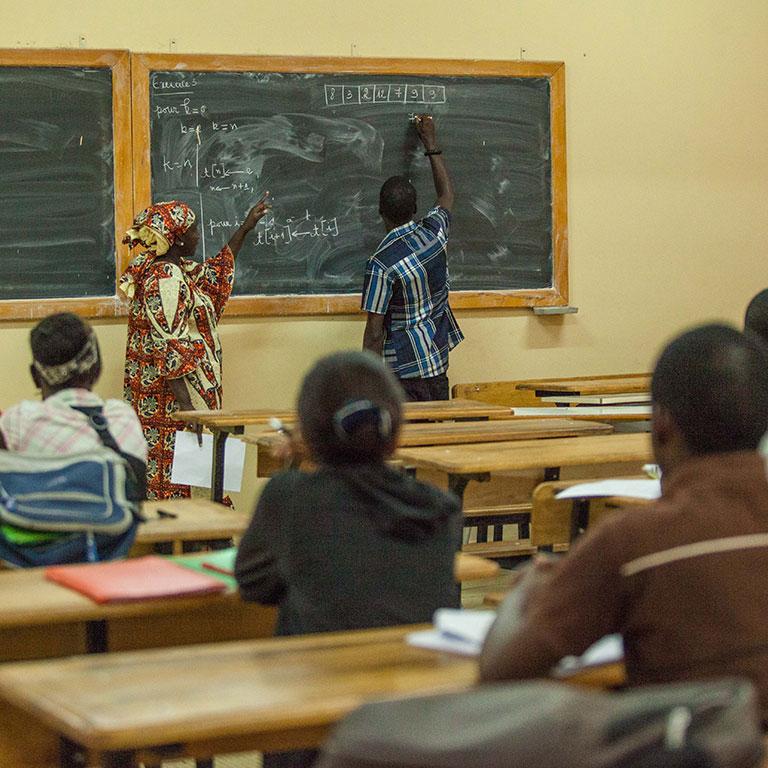Development Alternatives in Africa: Constructing Common Purposes and Agendas
archive


Garment factory in Accra, Ghana
Development Alternatives in Africa: Constructing Common Purposes and Agendas
Over the last forty years, a number of countries throughout Africa have been compelled to adopt various market reforms in exchange for development assistance from international financial institutions (IFIs) such as the World Bank and the International Monetary Fund. The World Bank’s conditional lending program, for example, prescribed a combination of policies ranging from privatization and fiscal austerity to free trade and deregulation. These “conditionalities” were codified through a set of Structural Adjustment Programs (SAPs) that were designed in accordance with a set of neoliberal ideas, or shared mental models, known as the “Washington Consensus” (Roy, Denzau and Willett, 2006). Initially coined by economist John Williamson (1990), the Washington Consensus (WC) described a broad (but by no means definitive) set of market-oriented objectives that mainstream economists believed would inspire economic growth and development. In an article entitled "Neoliberalism Oversold?,” IMF economists Ostry, Loungani, and Furceri (2016) remind us that “[t]here is much to cheer in the neoliberal agenda.” For example, “the expansion of global trade has rescued millions from abject poverty. Foreign direct investment has often been a way to transfer technology and know-how to developing economies. Privatization of state-owned enterprises has in many instances led to more efficient provision of services and lowered the fiscal burden on governments.” Unfortunately, however, a number of SAPs were based on distorted interpretations of WC policy objectives; for example, the call for fiscal discipline was often recast under SAPs as fiscal austerity. The bitter medicine of austerity, which was very painful and excessive in some cases, was understandably resisted in a number of developing countries where it was imposed.
Years of empirical data collected across the developing world have given us good reason to reconsider how SAPs have been applied (or misapplied). The experience of Ghana is a solid case in point. Once lauded as a "star pupil" of the WC in the 1980s, Ghana became “a test case of structural adjustment” (Rothchild, 1991, p.3), but in May of 2001, the World Bank was compelled to make a jaw-dropping admission that its SAPs failed to produce many of the wealth-creating benefits in Africa that they promised. Most notably, the World Bank conceded that the fiscal austerity measures intended to address burgeoning debt and inflationary pressures, failed to deliver “the necessary benefits to the people and communities who have borne the brunt of the harsh prescriptions” (Modern Ghana, May 15, 2001). World Bank Country Director, Peter Harrold, claimed that the global outcry against SAPs stemmed from the Bank’s failure to take into account the social impact of these initiatives (ibid). Relatedly, Ostry et al. (2016) argue that “[e]ven if growth is the sole or main purpose of the neoliberal agenda, advocates of that agenda still need to pay attention to the distributional effects.”
More recently, some highly respected economists at both the IMF and World Bank have made similar concessions. While continuing to promote market-oriented growth through the promotion of free trade, foreign direct investment, and privatization, they simultaneously began rethinking their positions on the liberalization of capital controls and fiscal austerity (Colford 2016). Most strikingly, they acknowledged that the rigid imposition of these particular measures on struggling economies often did more harm than good. Ostry et al. (2016) appear to corroborate the position of Nobel Laureates James Tobin and Joseph Stiglitz on the need for capital controls in countries prone to market failure. A series of financial crises associated with unfettered capital flows (which resulted in sudden surges and sudden stops) across Latin America, Europe, East Asia, Russia and elsewhere over the last two decades have led Ostry et al. (2016) to conclude that “…capital controls are a viable, and sometimes the only, option when the source of an unsustainable credit boom is direct borrowing from abroad.”

Students in African Classroom
Re-examining traditional models of development
As a consequence of these and other revelations, an increasing number of development organizations have begun to re-examine the ideological beliefs or mental models and views on international development and market-led growth. Statistician George Box (1976) once proclaimed that “all models are wrong, but some are useful.” And as conceded in recent years by a number of economists at the IMF and World Bank, some models imposed under the SAPs may have been detrimental. For example, Ostry et al. (2016; 2012) assert that “no fixed agenda delivers good outcomes for all countries for all times” and that “[p]olicymakers, and institutions like the IMF that advise them, must be guided not by faith, but by evidence of what has worked.”
Such concessions made by the World Bank and the IMF are a positive step in the right direction. Moreover, they afford us the opportunity to re-examine the core assumptions and beliefs that have long underpinned SAP-based development strategies. That said, African leaders and policymakers must begin exploring innovative ideas and pathways.
recently, some highly respected economists at both the IMF and World Bank have… [begun] rethinking their positions on the liberalization of capital controls and fiscal austerity.
Mental Models: A “useful” framework
The World Bank’s 2015 World Development Report: Mind Society and Behavior (WB Report) emphasizes the importance of developing mutual understandings or “Shared Mental Models” (SMM) when identifying problems and devising solutions. It drew specifically on the co-authored work of Arthur T. Denzau and Nobel Laureate, Douglass C. North on how mental models influence development-related investment decisions and strategies. If sustained development is to be achieved within Africa, it must be led through the cooperative efforts of African leaders who are guided by more dynamic and flexible shared mental models. Indeed, they need to be guided by models that transcend the age-old, narrowly-focused, Marxist anti-colonial vs. free-market capitalist ones.
African leaders must work together on an ongoing basis to cultivate improved shared mental models if they are to make accurate assessments of the appropriate development tools and processes needed to address common problems. This represents a sharp break from the approach assumed by anti-globalist rhetoricians and propagandists whose purpose is to disparage organizations like the IMF and the World Bank. Rather, leaders should probe and challenge development orthodoxy through constructive dialogues in an effort to work toward solutions that are mutually beneficial. Admittedly, getting various actors to cooperate across countries and agencies, while essential, is much easier said than done. This is because, as the WB Report illuminates, cooperation among governments, consultants, donors, investors, and NGOs is frustrated by the fact that each actor operates according to their own internal, and often discrete, understandings and rationales about how the world works.
Why mental models matter to development
According to the WB Report, “[m]ental models include categories, concepts, identities, prototypes, stereotypes, causal narratives, and worldviews.” Moreover, the WB states, “[w]ithout mental models of the world it would be impossible for people to make most decisions in daily life. And without shared mental models, it would be impossible in many cases for people to develop institutions, solve collective action problems, feel a sense of belonging and solidarity, or even understand one another.” (p. 62.) Mental models can be verbal and non-verbal, with the latter invoking what Michael Polanyi (2009) terms “tacit knowledge” which is premised on his claim that “we can know more than we can tell” (p.4.) Moreover, Denzau and North (1994) claim that “individuals with common cultural backgrounds and experiences will share reasonably convergent mental models, ideologies, and institutions” (pp. 3-4.)
In a world mired in uncertainty, however, we can never be sure that any theory or SMM is completely accurate. According to the 2015 WB Report, this is because “[t]here is immense variation in mental models across societies, including different perceptions of the way the world ‘works’” (p. 62.) In certain instances, SMMs can fill in gaps in our knowledge with information and claims that are consistent with our worldviews (p. 63.) At the same time, the WB notes, “we may ignore information that violates our assumptions and automatically fill in missing information based on what our mental models suggest is likely to be true” (p.63.)

IMF headquarters, Washington, D.C.
Often times, international development actors must contend with new or unfamiliar phenomena when working in continuously shifting social, political, and economic environments where essential prior experience or empirical data is often not available. As a number of countries across Africa witnessed in attempting to implement some SAP programs, these dynamics become exponentially more complicated as development actors attempt to apply one-size-fits-all free-market models across countries whose historical, social, cultural, political and economic experiences are very different. As noted above, some aspects of the Washington Consensus were very narrow and their SAP-based policy prescriptions were often imposed too rigidly.
Because each African country is very different, making assessments over which set of policies should be employed across them can be complicated. After all, SAPs were based on neoliberal economic mental models that engendered beliefs about optimality and risk that turned out to be highly flawed. The reason, in part, was that there was far greater variation in the economic, political and social circumstances of the individual countries than was accounted for in some neoliberal-based SAP models. Accordingly, some of these models were fraught with large blind spots. Development actors, however, can improve the odds associated with risk by deeply familiarizing themselves with the social, political and economic parameters of the environments in which they operate. In so doing, they will be better positioned to develop more accurate and flexible shared mental models that can be tailored as appropriate to fit the requirements of each country.
_____________
This essay is adapted from a framing text for the conference “Africa 2020: The Power of Sharing Mental Models to Foster Mutual Agendas” at Southern Utah University.
Colford, Christopher. “Neoliberalism’ and its excesses: After a sudden cloudburst of controversy, clear IMF insights on the 'disquieting' drawbacks of free-market dogma,” World Bank Blogs. Submitted on Saturday, June 25, 2016.
http://blogs.worldbank.org/psd/neoliberalism-and-its-excesses-after-sudden-cloudburst-controversy-clear-imf-insights-disquieting. Retrieved on January 14, 2019.
Box, George. (1976). “Science and Statistics,” Journal of American Statistics. 71: 791-799.
Ostry, Jonathan D., Loungani, Prakash, and Furceri, Davide. (2016). “Neoliberalism Oversold?,” Finance & Development. June. Vol. 53, No. 2. https://www.imf.org/external/pubs/ft/fandd/2016/06/ostry.htm. Retrieved on January 14, 2019.
Ostry, Jonathan D., Atish R. Ghosh, Marcos Chamon, and Mahvash S. Qureshi. (2012). “Tools for Managing Financial-Stability Risks from Capital Inflows,” Journal of International Economics, Vol. 88, No. 2, pp. 407–21.
Public gends. (2001). “World Bank admits mistakes in SAP implementation,” Modern Ghana. Submitted on May 15, 2001.
https://www.modernghana.com/news/14077/world-bank-admits-mistakes-in-sap-implementation.html. Retrieved on January 14, 2019.
Rothchild, Donald. (1991). Ghana: The Political Economy of Recovery. Boulder, Colorado: Lynne Rienner Publishers.



